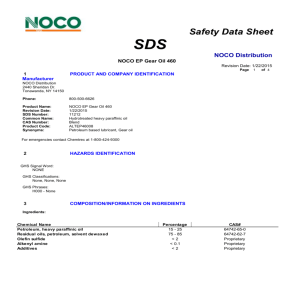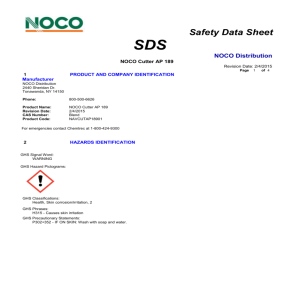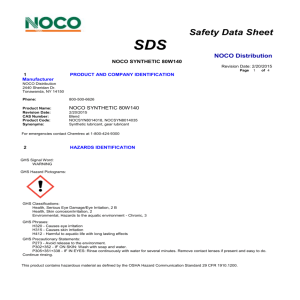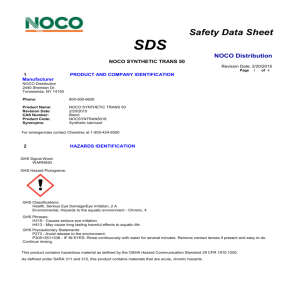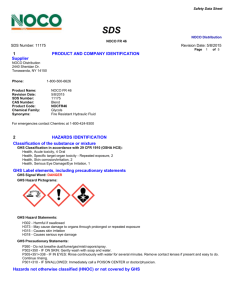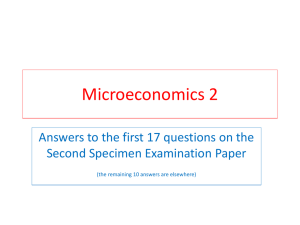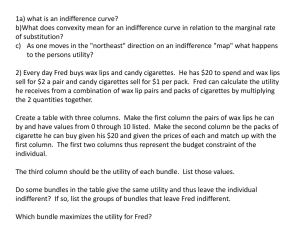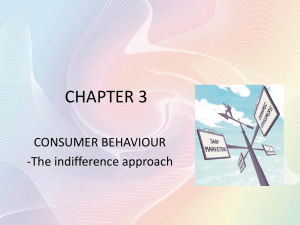Lecture 6: Demand and supply with income in the form of endowments
advertisement
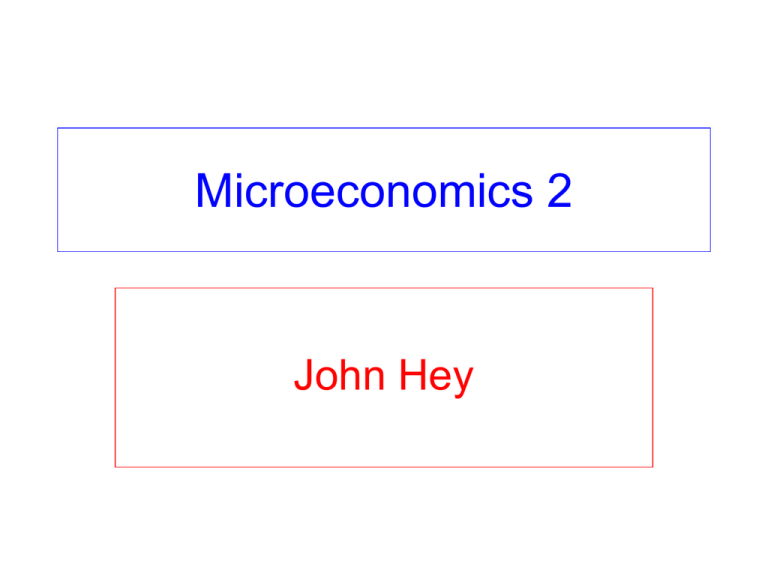
Microeconomics 2 John Hey I said that only economists know what indifference means, but I found this quote while I was looking for jokes on indifference: “The opposite of love is not hate, it's indifference. The opposite of art is not ugliness, it's indifference. The opposite of faith is not heresy, it's indifference. And the opposite of life is not death, it's indifference.” Elie Wiesel The only ‘joke’ I found is “Indifference will be the downfall of mankind, but who cares?” By the way, I found an immense amount of activity on the Facebook page! My Mum’s indifference curves Was she mad? q2 We will see at the end – remind me. B q1 Chapters 7 and 6 • In Chapter 7 income is in the form of money m. • In Chapter 6, income is in the form of endowments of the two goods: e1 and e2. • Otherwise everything is the same. • We will need this for Chapter 8 – the most important in the module. What was the structure of Chapter 7? • Individual with given preferences and income m faces prices p1 and p2 for two goods:1 and 2. • He or she is going to allocate his or her income buying quantities q1 and q2 of the two goods. • What he or she buys/demands depends on her preferences. • The relationship between q1 and q2 (the endogenous variables) and m, p1 and p2 (the exogenous variables) is called the demand function. What do we know from Chapter 7? First the intuition • Perfect Substitutes 1:a (a>0) • The individual buys either just Good 1 (if the relative price of Good 2 is greater than a); just Good 2 otherwise. • Perfect Complements 1 with a (a>0) • The ratio of the quantities bought is always equal to a. • Cobb-Douglas with parameter a (1>a>0) • The individual always spends a proportion a of the income on Good 1 • Stone-Geary with parameters s1, s2 and a (s >0 s >0 and1>a>0) • The individual first buys the subsistence quantities and then spends a proportion a of the residual income on Good 1. 1 2 What do we know from Chapter 7? (now the maths) • Perfect Substitutes 1:a (a>0) if p1/p2 < a then q1 = m/p1 q2 = 0 if p1/p2 = a then.... if p1/p2 >a then q1 = 0 q2 = m/p2 • Perfect Complements 1 with a (a>0) q1=m/(p1 + ap2) and q2 =am/(p1 + ap2) • Cobb-Douglas with parameter a (1>a>0) q1 = am/p1 and q2 = (1-a)m/p2 • Stone-Geary with parameters s1, s2 and a (s >0 s >0 and1>a>0) • q1 = s1+a(m-p1s1-p2s2)/p1 & q2 =s2+(1-a)(m-p1s1-p2s2)/p2 1 • 2 These formulas will be in the promemoria, but you should feel them. The optimal point – the formal condition • With indifference curves that are smoothly convex... • ... the optimal point is the point of tangency between the budget line and the highest possible indifference curve... • ...at which the relative price (the slope of the budget line) is equal to the marginal rate of substitution (the slope of the indifference curve). • Not true if they are not smoothly convex. From Chapter 7 to Chapter 6: are we economists or not? • • • • Economists are ... ... lazy ... ... efficient. In Chapter 7 income is in the form of money m. In Chapter 6, income is in the form of endowments of the two goods: e1 and e2. • What is the money value of this endowment? Call it m. • We have m = p1e1 + p2e2. • Let us just replace m with p1e1 + p2e2 everywhere! From Chapter 7 we have (gross demands) • Perfect Substitutes 1:a if p1/p2 < a then q1 = ( m )/p1 and q2 = 0 if p1/p2 = a then.... if p1/p2 >a then q1 = 0 and q2 = ( m )/p2 • Perfect Complements 1 with a q1 = ( q2 =a( m m )/(p1 + ap2) and )/(p1 + ap2) • Cobb-Douglas with parameter a q1 = a( m )/p1 and q2 = (1-a)( m )/p2 Hence for Chapter 6 (gross demands) • Perfect Substitutes 1:a if p1/p2 < a then q1 = (p1e1 + p2e2)/p1 and q2 = 0 if p1/p2 = a then.... if p1/p2 >a then q1 = 0 and q2 = (p1e1 + p2e2)/p2 • Perfect Complements 1 with a q1= (p1e1 + p2e2)/(p1 + ap2) and q2 =a(p1e1 + p2e2)/(p1 + ap2) • Cobb-Douglas with parameter a q1 = a(p1e1 + p2e2)/p1 and q2 = (1-a)(p1e1 + p2e2)/p2 Stone-Geary from Chapter 7 and hence for Chapter 6 (gross demands) • • • • • • • q1 = s1+a( m -p1s1-p2s2)/p1 and q2 =s2+(1-a)( m -p1s1-p2s2)/p2 hence q1 = s1+a(p1e1 + p2e2 -p1s1-p2s2)/p1 and q2 =s2+(1-a)(p1e1 + p2e2 -p1s1-p2s2)/p2 • Note linearity or otherwise in exogenous variables. So .... • We have done the maths but we now need to add intuition. (Remember you want to be economists not mathematicians.) • Note the difference between chapters 7 and 6 of a price change: • In both chapters this changes the slope of the budget line. • In chapter 6 it also changes the monetary value of the endowment p1e1 + p2e2 but it does not change m in Chapter 7. • In chapter 6 it rotates the budget line around the endowment point. Notice also .... • In this Chapter when we consider an individual starting with an endowment of the two goods... • ... if he or she wants more of one good then he or she has to sell some of the other. So... • Either q1 > e1 and the individual is a (net) demander of good 1 and (hence) q2 < e2 and the individual is a (net) supplier of good 2... • Or q1 < e1 and the individual is a (net) supplier of good 1 and (hence) q2 > e2 and the individual is a (net) demander of good 2; Chapter 6 • We consider an individual who starts with an endowment of the two goods. • We find his gross demands for the two goods (and hence his net demands). • We analyse how these demands change when the prices and his income change. (These variables are exogenous for the individual). • These are called comparative static exercises. Chapter 6 • We start with an individual with Cobb-Douglas preferences with parameter a = 0.5. • The Maple/html file contains other examples: • Cobb-Douglas with parameter a = 0.3; • Stone-Geary; • Perfect Substitutes; • Perfect Complements. • The shape of the demand curve depends upon the preferences. Chapters 6 and 7 • We use two spaces: • The first: to show the preferences of the individual and the budget line: • q1 on the horizontal axis and q2 on the vertical axis. • The second: to show the effect of changes in an exogenous variable on the demand: • q1 (and q2 ) on the vertical axis and the exogenous variable on the horizontal axis. • Note that this is different from usual demand and supply curves. Chapter 6 • The indifference curves are given by the preferences. • The budget constraint is given by the individual’s income and the prices of the two goods. • We denote by (e1, e2) the endowment and by (q1, q2) the quantities chosen to consume. The budget line is given by the equation: • p1q1 + p2 q2 = p1e1 + p2e2 • This is a line with slope • - p1/ p2 • which passes through the endowment point. • After showing this we go to the html file. q2 the budget line: p1 q1 +p2 q2 = p1 e1 +p2 e2 (p1 e1 +p2 e2)/p2 has slope = -p1/p2 and passes through (e1,e2) e2 X (p1 e1 +p2 e2 )/p1 e1 q1 Let’s go to Maple My Mum’s indifference curves Was she mad? q2 No – just contented. B q1 Chapter 6 • Goodbye!
